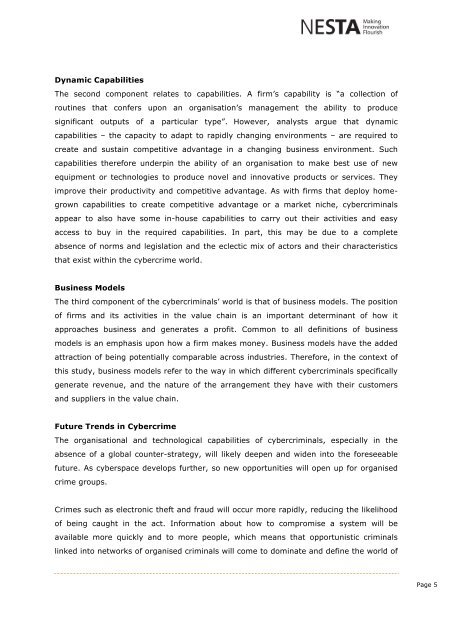NESTA Crime Online - University of Brighton Repository
NESTA Crime Online - University of Brighton Repository
NESTA Crime Online - University of Brighton Repository
You also want an ePaper? Increase the reach of your titles
YUMPU automatically turns print PDFs into web optimized ePapers that Google loves.
Dynamic Capabilities<br />
The second component relates to capabilities. A firm’s capability is “a collection <strong>of</strong><br />
routines that confers upon an organisation’s management the ability to produce<br />
significant outputs <strong>of</strong> a particular type”. However, analysts argue that dynamic<br />
capabilities – the capacity to adapt to rapidly changing environments – are required to<br />
create and sustain competitive advantage in a changing business environment. Such<br />
capabilities therefore underpin the ability <strong>of</strong> an organisation to make best use <strong>of</strong> new<br />
equipment or technologies to produce novel and innovative products or services. They<br />
improve their productivity and competitive advantage. As with firms that deploy home-<br />
grown capabilities to create competitive advantage or a market niche, cybercriminals<br />
appear to also have some in-house capabilities to carry out their activities and easy<br />
access to buy in the required capabilities. In part, this may be due to a complete<br />
absence <strong>of</strong> norms and legislation and the eclectic mix <strong>of</strong> actors and their characteristics<br />
that exist within the cybercrime world.<br />
Business Models<br />
The third component <strong>of</strong> the cybercriminals’ world is that <strong>of</strong> business models. The position<br />
<strong>of</strong> firms and its activities in the value chain is an important determinant <strong>of</strong> how it<br />
approaches business and generates a pr<strong>of</strong>it. Common to all definitions <strong>of</strong> business<br />
models is an emphasis upon how a firm makes money. Business models have the added<br />
attraction <strong>of</strong> being potentially comparable across industries. Therefore, in the context <strong>of</strong><br />
this study, business models refer to the way in which different cybercriminals specifically<br />
generate revenue, and the nature <strong>of</strong> the arrangement they have with their customers<br />
and suppliers in the value chain.<br />
Future Trends in Cybercrime<br />
The organisational and technological capabilities <strong>of</strong> cybercriminals, especially in the<br />
absence <strong>of</strong> a global counter-strategy, will likely deepen and widen into the foreseeable<br />
future. As cyberspace develops further, so new opportunities will open up for organised<br />
crime groups.<br />
<strong>Crime</strong>s such as electronic theft and fraud will occur more rapidly, reducing the likelihood<br />
<strong>of</strong> being caught in the act. Information about how to compromise a system will be<br />
available more quickly and to more people, which means that opportunistic criminals<br />
linked into networks <strong>of</strong> organised criminals will come to dominate and define the world <strong>of</strong><br />
Page 5
















